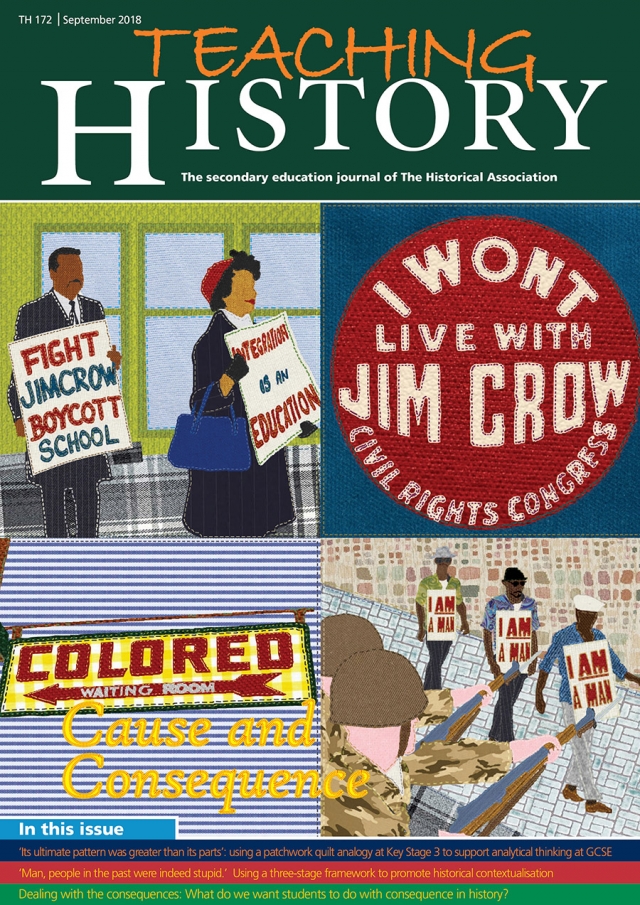Teaching History 172: Out now
Journal news

Access Teaching History 172 here (free to HA Secondary Members)
Editorial: Cause and consequence
While we suspect that few history teachers would accept EH Carr’s famous dictum that ‘the study of history is a study of causes’, causality is such a mainstay of school history that it seems surprising that an edition of Teaching History devoted to it has not been published before. Causal questions have long dominated GCSE and A-level exam specifications and thus have an outsized influence on the taught curriculum. Yet among historians and philosophers of history, the centrality of causality to the discipline has been in steady decline since the 1960s. The historian David Reynolds attributes this to a combination of the increasing complexity of available evidence, a proliferation of different types of history and a shift in the locus of activity from explanation to representation – as he puts it, ‘from causes to meanings’.
Such a radical shift seems unlikely to occur in school history in the near future. For better or worse, the study of causes is still seen as central to the structure of the discipline.5 This perhaps explains why history teachers and history education researchers continue to be preoccupied by it, despite the existence of an extensive, if not exhaustive, body of work debating the characteristics of causal argument and how best to teach it. As one of the contributors to this edition put it in a moment of doubt, ‘what else is there to say?’ As it turns out, plenty.
Indeed, this edition is a testament to the vibrancy of the discourse that exists within the history teaching community, both in the UK and further afield. The history teachers and history education researchers who share their work on these pages all push the boundaries of our shared professional knowledge about causality by challenging existing assumptions, theorising new goals or breaking new ground. But they do so by acknowledging and building upon the work of the many others who have gone before, contributing to the joined-up discourse that is so vital if we are not to waste time reinventing wheels, both square and round.
A striking feature of all the articles in this edition is a concern with the kinds of substantive knowledge pupils need if they are to produce valid causal arguments, particularly the broader contextual knowledge pupils need to reason with causes, and how pupils can be helped to both acquire it and deploy it in their causal arguments.
Hugh Richards tackles this through the lens of medium-term planning and the well-established practice of using enquiry questions to structure planning. Questioning the efficacy of building pupils’ knowledge of macro-narratives as an ‘unfolding story’, he argues that giving pupils an overview at the start of the enquiry can help them break out of narrative and into analysis more easily.
In contrast, Durbin frames the acquisition of contextual knowledge as an issue of long-term curriculum planning. He questions what kind of knowledge ‘hinterland’ – residual contextual knowledge – pupils need if they are to be ready for the challenges of GCSE. Seeking ways to build this hinterland at Key Stage 3, he turned the conventional causal question (‘why did “X” happen?’) on its head, instead asking ‘why did “X” not happen?’ Tim Huijgens and Paul Holthuis likewise address the kinds of substantive knowledge pupils need to explain events and the actions of people in the past, but are primarily concerned with how pupils can be taught to deploy that knowledge. They propose a three-stage framework to support historical contextualisation that seeks to make pupils consciously aware of their own presentist assumptions and then apply their wider period knowledge to explain and interpret historical phenomena.
Jim Carroll addresses a specific form of causal reasoning: the use of counterfactuals. Dissatisfied with his A-level students’ attempts at counter-factual reasoning and puzzled about why they seemed to be able to reason with counterfactuals in some contexts yet struggled in others, Carroll set out to theorise what types of counterfactual questions are most likely to elicit a rigorous response and what kinds of substantive knowledge students need if they are to deploy the ‘historical imagination’ that he argues is necessary to argue counterfactually.
As Carroll makes clear, arguing with counterfactuals necessarily entails arguing about consequences. Faced with preparing pupils to answer GCSE and A-level questions about historical consequences, but uncertain about what it actually means to reason about them, Molly-Ann Navey turned to historical scholarship in search of a gold standard. In this article, Navey recounts her efforts to teach pupils to characterise, weigh and interrelate historical consequences and by so doing, theorises consequence as a worthwhile curricular goal.
Rachael Cook contributes to recent debates about curriculum planning and progression models at Key Stage 3 by addressing how progression in causal reasoning might be planned for across a key stage. The model she proposes will undoubtedly stimulate further discussion.
Finally, Jess Angell and Tim Jenner offer a powerful account of how they have sought to build a culture of reading among all their pupils. They share a winningly simple and practical idea – the creation of a history lending library – that is seeing encouraging results.

